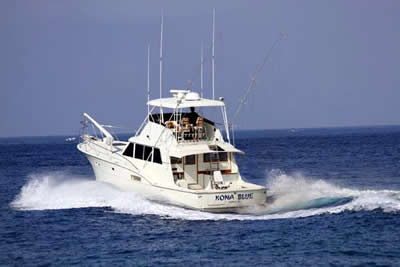


The sunny Kona District stretches for about 60 miles from Kona International Airport to beyond Kealakekua Bay on Hawaii Island’s lava-lined western coast. Along this expansive area, you’ll find everything from coffee farms to historic Hawaiian landmarks.
In fact, King Kamehameha actually spent his final years in Kailua-Kona. Today, Historic Kailua Village (Kailua-Kona) is a bustling, gathering place in the heart of the district, just a 15-minute drive south of Kona International Airport. Home to shops, restaurants and nightlife, you can conveniently take a walking tour of Kona’s history at places like Hulihee Palace, Mokuaikaua Church and the Ahuena Heiau.
Angling is a method of fishing by means of an "angle" (fish hook). The hook is usually attached to a fishing line and the line is often attached to a fishing rod. Fishing rods are usually fitted with a fishing reel that functions as a mechanism for storing, retrieving and paying out the line. The hook itself can be dressed with lures or bait. A bite indicator such as a float, and a weight or sinker are sometimes used. Angling is the principal method of sport fishing, but commercial fisheries also use angling methods such as longlining or trolling. Catch and release fishing is increasingly practiced by recreational fishermen. In many parts of the world, size limits apply to certain species, meaning fish below and/or above a certain size must, by law, be released.
Although most anglers keep their catch for consumption, catch and release fishing is increasingly practiced, especially by fly anglers. The general principle is that releasing fish allows them to survive, thus avoiding unintended depletion of the population. For species such as marlin and muskellunge but, also, among many bass anglers, there is a cultural taboo against killing bass for food. In many parts of the world, size limits apply to certain species, meaning fish below a certain size must, by law, be released. It is generally believed that larger fish have a greater breeding potential. Some fisheries have a slot limit that allows the taking of smaller and larger fish, but requiring that intermediate sized fish be released. It is generally accepted that this management approach will help the fishery create a number of large, trophy-sized fish. In smaller fisheries that are heavily fished, catch and release is the only way to ensure that catchable fish will be available from year to year.
The practice of catch and release is criticised by some who consider it unethical to inflict pain upon a fish for purposes of sport. Some of those who object to releasing fish do not object to killing fish for food. Adherents of catch and release dispute this charge, pointing out that fish commonly feed on hard and spiky prey items, and as such can be expected to have tough mouths, and also that some fish will re-take a lure they have just been hooked on, a behaviour that is unlikely if hooking were painful. Opponents of catch and release fishing would find it preferable to ban or to severely restrict angling. On the other hand, proponents state that catch-and-release is necessary for many fisheries to remain sustainable, is a practice that that generally has high survival rates, and consider the banning of angling as not reasonable or necessary.
Our Boat1971, 53 foot Hatteras yacht.